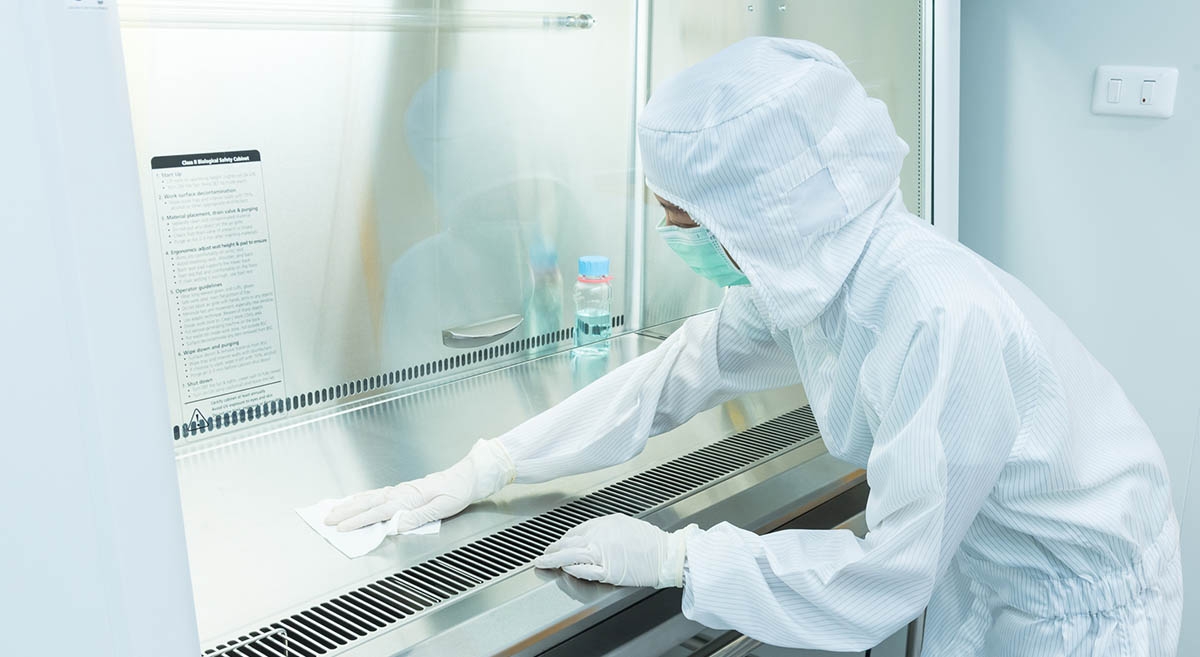
Risks from biocontainment labs: A puzzling lack of realism about human fallibility prevails
ABOVE: A scientist in sterile coveralls cleans a Biological Safety Cabinet (BSC) in a cleanroom facility. (PHOTO: iSTOCK)
We will never know whether SARS-CoV-2, the virus that causes Covid-19, began to spread in Wuhan in late 2019 because of a lab leak. Was there some small handling mistake with a sample in the collection of coronaviruses being studied at the Wuhan Institute of Virology, or did the virus pass naturally from bats to some other host, and thence to humans without having been collected, moved, stored and possibly subjected to some study? But even if the Covid-19 pandemic did begin with a lab leak, it would only be the most recent in a long line of failures in biocontainment by laboratories across the globe.
Indeed, the world’s scientific community has, for generations, been of two minds about whether certain types of laboratory work on dangerous human pathogens was a good or bad idea. When modern techniques of genetic manipulation first became available, there was a period when the international scientific community agreed upon and instituted a moratorium on certain types of experiments on such pathogens. The arguments against the work focussed on the risks of failure of biocontainment, while the arguments in favour focussed on the need to carry out such work in order to be able to design and produce cures and preventatives for such diseases, and whatever new forms they mutated to.
After a time, the moratorium was lifted. Those who had wanted it lifted had argued, with some cogency, that (a) not everyone was honouring the moratorium anyhow, (b) in certain quarters work on unethical bioweapons would continue in secret and could not be regulated, and (c) there was, by then, a generally agreed upon classification of levels and practices of biocontainment, and, if appropriate standards could be maintained, the benefits of the knowledge gained outweighed the risks of leaks.
But, historically, there have been plenty of leaks. More on that below, but first, a bit of formalism on biocontainment jargon.
The classification of biocontainment levels for laboratories has, for the most part, settled on four generally accepted levels of procedures and precautions. In Canada these are termed Containment Levels, or CL, and in the United States they are called Bio-Safety Levels, or BSL. The highest level is CL-4, which is the same as BSL-4. We hear more use of the term BSL because the US nomenclature dominates the airwaves, so I shall use that terminology, except when referring specifically to Canada.
BSL-1 and 2 are fairly easily accomplished, and most labs have no problem meeting that standard. But BSL-3 and BSL-4 are much more stringent. Historically, most coronavirus work was at BSL-3, while BSL-4 was mostly the province of the really scary pathogens like the highly lethal hemolytic viruses, such as Ebola and Marburg. Perhaps today, out of increased caution, some pathogens formerly worked on at the BSL-3 level may now be studied using BSL-4 containment protocols.
The same classification system for containment exists for animal pathogens, and, in some cases, plant pathogens, and there are many BSL-3 and 4 labs in the world that do not work on any human pathogens at all, but are focussed on preventing, curing or understanding animal and plant diseases.
Canada has only a single CL-4 lab at this time, the Canadian Science Centre for Human and Animal Health, in Winnipeg. But there are Level 4 labs in at least 23 countries, and, while the exact number of such labs that exist is not precisely known, it probably approaches 100. There are, as well, a few thousand Level 3 labs in the world.
And humans are fallible. Mistakes are made. Leaks occur. All modern deaths from Smallpox, for example, have been caused by lab leaks, notably three outbreaks in the UK (1966, 1972 and 1978). Anthrax deaths in Russia were a lab leak, and Marburg escaped from a lab in Germany in 1967 and one in Russia in 1990. It is also pretty clear that the H1N1 influenza strain that caused the 1977 pandemic was a lab-leaked strain.
SARS has escaped from labs in Singapore, Taiwan and China. Ebola escaped from labs in the UK (1976) and Russia (2004-5). A prion disease escaped from a French lab in 2019. And in the US, in 2009, an associate professor at the University of Chicago was killed by a lab leak of the bacterium Yersinia Pestis, the same pathogen that was known as the Plague in Europe, which, in the six years 1347-53, killed more than a third of the population of Europe.
And large numbers of leaks with little widespread consequence have occurred, which had the effect of dulling the scientific community’s sense of concern for the problem.
Consequently, to expect that even the most stringent containment protocols are an absolute defence against human error all the time is the height of folly, of course.
How often do we hear the expression, “To err is human”? If it were possible to train professionals to always be error-free, at least when their own lives or livelihoods were at stake, we would never hear of commercial aircraft crashes that were due to pilot error. Or ship collisions at sea. Or sponges being left inside surgical patients, for that matter. Yet the dangerously arrogant assumption that, somehow, the operation of biocontainment-rated labs is the unique exception is widely prevalent. That stance reflects a complete lack of realism about human fallibility.
But, for the world’s Level 3 and Level 4 laboratories, there is a simple way to dramatically reduce the chance that the inevitable but rare error will result in an epidemic or pandemic. And, by not thinking the matter through, we’ve dropped the ball on that simple safeguard.
The vast majority of Level 3 and Level 4 biocontainment facilities are in cities. For the ones associated with centres of higher learning (which is nearly half of them), they were built to be essentially co-located with their universities. The people who do the experiments in them live their lives in those cities, go home to their families in those cities every night, go to parties, and shop on the weekends. Bad idea.
The logical concept for a Level 3 or 4 lab ought to be to place it in a less populated space, even though it could be near a city. But it would need to be more than just a lab building. It would have to be a self-contained campus, so that there would be living quarters as well, plus all basic services. Those carrying out the work there, when finished with their direct experimental work with the pathogens, would move from their working living quarters to an on-site quarantine living facility for a prescribed period before returning to their homes, their home university, and their normal lives. So would folks whose tasks required them to come in contact with the researchers actively engaged in the experiments or quarantined.
As a former medical research scientist myself, I know that the number of days in a year that I actually carried out my experiments was small compared to the great swaths of time spent designing and preparing for the experiments, analyzing data, writing grant applications and papers, and even building equipment. Consequently, the disruption to the life of a researcher to take this extra precaution during the period of actual manipulation of the pathogens is unlikely to be extreme.
Now, I’m sure that the rejoinder to my suggestion will be that the academic bio-scientists who would do such experiments could never be induced to work in such a dislocating environment, and wouldn’t hear of having to go off-site from their home universities to carry out certain experiments. But that is a small matter of cultural adjustment. After all, their colleagues who are archeologists go to digs in remote locations. Oceanographers go to sea (even the ones that get seasick). And while automation does help in some cases, some of their astronomer colleagues still go to observatories in Hawaii, or in the Atacama Desert of Chile. The historians go to remote archives. The wildlife biologists go, well, into the wild, from time to time. The glaciologists have an even worse time, because they go to damned cold places.
But, when it comes to biocontainment, to avoid the extra inconvenience and extra cost of the extra layer of protection that I am suggesting, the scientific and regulatory community is exposing the entire human race to an unacceptable and conceivably terminal risk. The assumption that they can always be perfect flies in the face of all other human experience. How can they always be error-free when no other group is? And, indeed, how can they be error-free when their own colleagues and predecessors have failed on that score so many times before? I used the expression “dangerously arrogant” earlier in this piece, and I wonder if perhaps that may be an understatement.
I started this piece with a reference to SARS-CoV-2. While we do not know that a lab error played a role in unleashing it upon us, the majority of experts maintain an open mind on that question and do not rule it out. But the disease it causes is not a particularly effective people-killer, having so far done in, by official counts, only about 6 million people, though the actual figure is likely to be vastly higher. But the cost to humankind of the spread thus far of this single pathogen is so much vaster than any cost of doing a dramatically better job of laboratory biocontainment that it is rather like comparing the weight of an elephant to that of a bee.
However, the political cost of appearing to “waste” money on an over-cautious approach to biocontainment is certainly one driver behind our failure to do it better. Humans routinely do a bad job of preparing for very unlikely but very consequential events. We’ve all heard variations on the notion that, when faced with a choice, people and organizations deal with and invest in “urgent” matters at the expense of pushing off to the future the investment in those “important” matters that are not seen as immediate. We have certainly seen this worldwide in the almost universal poor preparation for the current pandemic, despite plenty of learned advice to most governments of developed states to prepare better, and despite government claims that they were prepared (sort of).
So, what can be done to create a climate of greater care in biocontainment? Perhaps a lesson can be drawn from some of the (admittedly imperfect) safeguards around nuclear power generation.
Because of the existence of nuclear and thermonuclear weapons, the word “nuclear” continues to be scary for most folks. It is just over 2/3 of a century since the first full-scale nuclear plant for generating electricity was put into operation (1954). Yes, there have been some mistakes, with all three of the really notable ones due to a combination of slightly silly design and bad operator decisions (in one case exacerbated by a tsunami). The Fukushima evacuation may have caused or accelerated up to 2,300 deaths (not from radiation, but from displacement and chaos), and radiation from Chernobyl, worldwide, may have caused or accelerated up to 60,000 deaths, using the most extreme model. Three Mile Island was expensive, but the most thorough analyses suggest that no lives were lost as a result of the accident. So, those lost from the three aforementioned high profile nuclear accidents total a fraction of one percent of the more than seven million lost due to just the 1977 lab-leak H1N1 pandemic, and, if perchance Covid is eventually to be found to be lab-leak related, it would be a lab leak that will have caused or accelerated the deaths of vastly more millions than the 1977 pandemic before it is done.
Is nuclear power generation inherently safer than studying and modifying dangerous pathogens in BSL-3 and BSL-4 labs? I suspect that it is, but I don’t know. But I do know that the world took the concerns about nuclear power generation seriously, which is why an international agency with global reach exists to put pressure on nation states to behave responsibly in their development of such nuclear capabilities. That agency is the IAEA, the International Atomic Energy Agency. It has existed since 1957, and promotes safety in nuclear power generation, discourages nuclear weapon development, and promotes the distribution of isotopes and equipment for cancer therapies to nations that cannot easily afford them. It has 173 member states, including any that we would think of as capable of work on nuclear projects.
The IAEA is imperfect, and its responses have occasionally been criticized as too slow and/or too mild. In part, this is because the agency understands that the only tools it has for applying pressure on any nation state to allow access or to comply with its recommendations are its power to cause embarrassment or loss of face. These tools, however, should not be underestimated. And it did win a Nobel Prize in 2005. Despite its shortcomings, it’s a damned sight better than not having it at all.
I would suggest that biocontainment of dangerous pathogens needs the same type of international regulatory and promotional agency of good repute that has brought some order, caution, and standards of practice to nuclear issues for 65 years. And Canada could make some waves by proposing, championing and offering to provide some seed money for such an undertaking. If such an agency existed, getting BSL-3 and BSL-4 labs properly located and isolated would be a doable international task. Additionally, it would be a fine forum for establishing best practices for the limits on gain-of-function studies and other work deemed to have some inherent risk.
If our PM wants a flagship peaceful international project to promote, he could do far worse than the creation of the International Agency for Monitoring Biocontainment and Instituting Controls (IAMBIC). He could even get poetic about it. Yes, the acronym is intentional.
Of course, there is the small risk that launching a campaign for the creation of such an agency at this time might be taken by China as a veiled accusation about the origins of Covid, despite the obvious need for such an entity, given the extensive worldwide history of lab leaks. And, as we have seen recently, a hissy fit by the government of China can involve hostage taking. But I think any outrage or strong opposition from that quarter unlikely, because the superb tacticians in Beijing understand that overreaction and self-incrimination look a lot alike.







